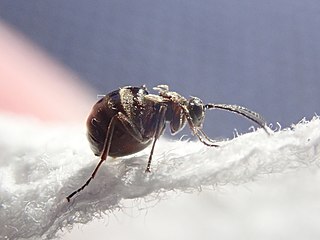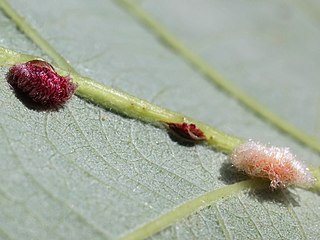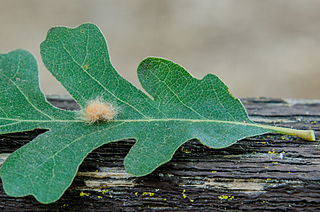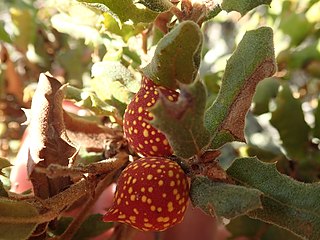
Dryocosmus are a genus of gall wasps. They are cyclically parthenogenetic insects that induce galls on plants in the family Fagaceae.

Neuroterus is a genus of gall wasps that induce galls on oaks in which the wasp larvae live and feed. Some species produce galls that fall off the host plant and 'jump' along the ground due to the movement of the larvae within.

Cynips is a genus of gall wasps in the tribe Cynipini, the oak gall wasps. One of the best known is the common oak gall wasp, which induces characteristic spherical galls about two centimeters wide on the undersides of oak leaves.

Andricus is a genus of oak gall wasps in the family Cynipidae.

Cynipini is a tribe of gall wasps. These insects induce galls in plants of the beech and oak family, Fagaceae. They are known commonly as the oak gall wasps. It is the largest cynipid tribe, with about 936 to 1000 recognized species, most of which are associated with oaks. The tribe is mainly native to the Holarctic.

Acraspis is a genus of gall wasps in the family Cynipidae. The following species are recognised in the genus Acraspis:

Feron kingi, the red cone gall wasp, is a species of gall wasp in the family Cynipidae.
Striatoandricus is a genus of Neotropical gall wasps (Cynipidae). There are six described species, four of which were formerly included in Andricus. All species induce galls on oaks in which their larvae live and feed.

Acraspis quercushirta, the jewel oak gall wasp, is a species of gall wasp in the family Cynipidae, tribe Cynipini, found in North America.
Antron is a genus of gall wasps in the tribe Cynipini, the oak gall wasps. Some authors have included it within the genus Cynips but it was recently resurrected. The genus was established by Alfred Kinsey in 1930.

Druon ignotum is a species of gall wasp in the family Cynipidae.

Druon fullawayi, also known as the yellow wig gall wasp, is a species of gall wasp in the family Cynipidae. It was previously placed in the genus Andricus. William Beutenmüller described the female adult wasps as 1.5-2.25 mm long, black with brown mouth parts and brown legs. The galls of D. fullawayi are tan or yellow, woolly, and measure 5-8 mm in diameter. Each gall holds a single chamber for larvae. They are found in California on oak trees, especially Quercus lobata.

Feron crystallinum, also known as the crystalline gall wasp, is a species of gall-forming wasp in the genus Feron. Its galls are pink and covered in hairs that are white, red, or brown. These galls are often massed together in clumps that can cover the underside of leaves. Individual galls are 12-14 mm high, 7 mm across, and have a single chamber for larvae. The unisexual female generation emerges in late winter, and the bisexual generation of males and females emerges in March. They are found in all species of oaks in California.

Burnettweldia is a genus of oak gall wasps in the Nearctic.

Feron gigas, also known as the saucer gall wasp, is a species of gall-forming wasp in the genus Feron. It induces galls on the leaves of scrub oaks, blue oaks, and Engelmann oaks. The galls produced by its all-female generation, which emerges in winter, are 3-4 mm wide, circular with raised edges. They are red, pink, brown, or purple. The larval chamber exists as a raised bump in the gall's center. The bisexual generation produces galls that are brown and cone-shaped.

Feron pattersonae, also known as the plate gall wasp, is a species of oak gall wasp in the genus Feron. Their hosts are among the white oaks grouping of oaks, with blue oak being common.

Kokkocynips is an American genus of gall wasps in the family Cynipidae. There are about 8 described species in the genus Kokkocynips with several others still undescribed.

Acraspis guadaloupensis is a relatively uncommon species of cynipid wasp that produces galls on intermediate oaks. The intermediate oak disc wasp was first described in 1911 and has been moved between genera more than once. Distribution is limited to California in North America. The flattened galls appear on leaves of Quercus chrysolepis, the canyon live oak.

Feron bakkeri, also known as the pinched leaf gall wasp, is a relatively uncommon species of gall-inducing hymenopteran. They produce pink leaf galls on Oregon oaks and scrub oaks. The distribution of this wasp is California and Oregon in North America. It was previously placed in the genus Andricus.

















